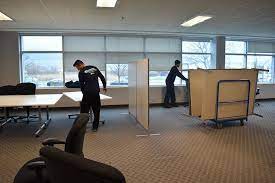Whether it is because of expansion, consolidation, or a strategic move, Office Movers can be both exciting and intimidating for businesses. The process of moving an entire office requires careful planning and execution. In this guide, we will delve into the key aspects of office moving, providing useful tips and tactics to ensure a seamless change for companies of all sizes.
Strategic Planning:
Careful strategic planning is the first step toward a successful office move. Determine why the move is necessary, set specific goals, and create a timeline. Involve important stakeholders, such as department heads and IT staff, early on to ensure a comprehensive understanding of the requirements. Assign tasks to a specialized moving team, clearly defining their roles and responsibilities.
Budgeting:
A clear budgeting process helps avoid financial surprises and ensures a well-managed relocation. Create a detailed budget that covers every aspect of the move, from hiring professional business movers to potential renovations at the new space. Account for unforeseen expenses and consider negotiating with moving companies for competitive rates.
Professional Office Movers:
A successful office movers depends on choosing the right moving company. Look for reliable movers with experience managing commercial moves. Compare services, get quotes from several companies, and make sure the moving company offers full solutions, which include packing, moving, and unpacking. To protect against any potential damages during the journey, confirm the company’s insurance coverage.
Technology Infrastructure:
Plan the disconnecting and reinstalling of servers, PCs, and other equipment. Back up important data to avoid losing it during the move. Hire IT business movers with experience in handling the delicate relocation of technology. Work closely with the IT department to oversee the smooth change of the technology infrastructure.
Employee Communication:
A well-informed and engaged workforce is key to minimizing disruptions during the change. To that end, keep lines of communication open and clear with employees throughout the entire moving process. Offer assistance in adjusting to the new workspace, address concerns, and provide regular updates on the relocation timeline.
Space Planning:
Maximize natural light, create functional workspaces, and prioritize ergonomic furniture to foster a positive and productive work environment. Involve key stakeholders in the design process, taking into account the unique needs of each department. Optimize the new office layout to enhance productivity and collaboration.
Regulatory Compliance:
Assure adherence to zoning and local laws at the new and existing office locations. Secure any required permissions well in advance to prevent setbacks. Take care of accessibility and safety issues to ensure a seamless change that complies with legal requirements.
Furniture and Equipment:
Make a list of all the furniture and equipment that is currently in place, marking any that needs to be upgraded or replaced. Get rid of outdated stuff ethically, and work with the moving company to ensure that expensive items are elated safely. Label everything so that it is easier to unpack at the new place.
Employee Assistance Programs:
Employee assistance programs should be put in place to support staff during this change. Resources like counseling services, relocation guides, and help with personal matters related to the move should be made available. Employee well-being should be prioritized to keep morale high and productivity levels high.
Testing and Quality Assurance:
Before the actual move, thoroughly test all of the new office’s equipment and systems, including the IT infrastructure, communication systems, and security protocols. Quality assurance procedures should be put in place to quickly identify and resolve any issues, reducing downtime after the move.
Post-Move Evaluation:
After the move is finished, carry out a thorough assessment to determine whether the relocation was successful overall. Get input from the staff, pinpoint areas that need work, and record the lessons learned. This kind of post-move assessment is very helpful for future moves and ongoing enhancements.
Conclusion:
Office movers are complex processes that require careful planning and execution. Businesses can guarantee a smooth change to a new workspace by implementing a strategic approach that includes planning, budgeting, technology infrastructure management, employee communication, space planning, regulatory compliance, furniture and equipment handling, employee assistance programs, testing, and post-move evaluation. Hiring professional business movers with experience in commercial relocations increases the likelihood of a successful move even more.

